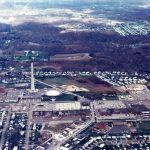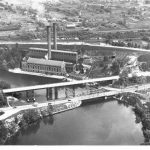The Gorge is usually considered as starting on the Cuyahoga River near Front Street or at the south end of the Glens and running just past Cuyahoga Street to the junction with the Little Cuyahoga River.
The towering cliffs, rocky banks, scraggy trees clinging tenaciously to the barren banks of the river, the graceful Big Falls with its overhanging large trees and the famous Old Maid’s Kitchen looking out over the falls area; form a delicious retreat for nature lovers seeking solitude and beauty. – That is how the Gorge was described before 1912.
Other notices said the Gorge is beautiful at all seasons; in spring the trees, vines and brushes are clothed in bright green verdure; as summer settles on it a gold glow of balminess; in autumn, it is rich with its browns and reds and then even in winter it presents myriadal pictures of icicles beneath the high cliffs.
The Gorge was exploited commercially when the Northern Ohio Power and Light Company built a power plant at the southeast corner of the High Street car bridge over the Cuyahoga River in 1912 and for operation of the plant constructed a 70 foot high concrete dam on top of the beautiful Big Falls. Thus, the falls became the spillway of the dam.
As part of the power development, a turbine plant was built on the south bank of the river half-mile downstream with a six foot concrete feeder pipe running from the dam to the turbine. The turbine plant is no longer needed in their operation, so in 1977 the concrete pipe line was removed by a modern construction method, a helicopter.
Also, to construct these power-supplying monstrosities, in 1912 it was necessary to fill and level off the old Chuckery ditch along the south bank of the river from Front Street west to build a railroad track over which construction material was moved for building the damn and turbine, and later on the High Level Bridge. The track remained in place to haul in supply material to operate the turbine plant.
The Gorge, or what was left of it, was further exploited commercially in 1919 when Silver Lake Park closed. Some of its amusement equipment was moved into the area just west of Front Street on the north bank of the river and Riverside Park opened with a merry-go-round, roller coaster, roller skating rink, tunnel of love, a very large dance hall that partly extended over the river, a row boat livery, and concession stands.
The park operation as relatively short-lived and its parking area at Front Street has now been enlarged for the benefit of visitors to the Gorge Metropolitan Park. The skating rink was moved to Elizabeth Park on the Little Cuyahoga River where it serv[ed] as a recreation hall for the park’s young folks.
In 1918, the Akron District Boy Scouts built a large ledge among the rocky cliffs on the north side just east of the High Level Bridge. In 1932, they moved Boy Scout operations to the new camp at Peninsula with very little damage to the Gorge’s natural surroundings.
A plus for Cuyahoga Falls in general was the fact that all this Gorge construction brought many working men to this area and many established their homes in the Grant Farm allotment development south of Sackett Avenue, thus causing the area to really boom.
A destructive feature of the Gorge’s construction was the destruction of the footbridge across the river, just west of the dam. This had been the only place to walk across the river between the Front Street car bridge and the Cuyahoga Street covered bridge. This footbridge was used by many walking to Akron and by nature lovers and should have never been destroyed.
Another lost attraction was a real[ly] good swimming hole at the foot of the falls. It is spoiled by the seventy foot falls over the dam’s spillway causing the water to move too swiftly and splash considerably.
The Gorge area should be excluded from ever being exploited commercially again as the entire area is now the established Gorge Metropolitan Park.
By Eric Thompson
















I grew up on Hillcrest Dr. just above the Gorge. I spent my childhood down there. The dumbest thing I and a friend ever did was getting inside the pipe by crawling through the guard and walking inside for about a quarter mile. After getting out I told my buddy I’m never doing that again. All you think about when your in there is if they are releasing the water.
As for the Dam I have walked across the top of it when the water wasn’t running several times. There is a fence on the Falls side and all you had to do is grab hold and swing your self around it. When you got to the flow section you had to be sure the top wasn’t still muddy or you had a long fall. One time when we were out there the Park Ranger saw us and started yelling at us to get back, we told him if you want us come out here and get us. He stayed put.
Frank, that’s funny. In 1973, a friend and I went down there many times that summer and rafted the river from whirlpools to old powerhouse. We used to walk the pipe to get back up to the dam area. On a good day (best right after a rainy spell), we could shoot it about 6 times or more. When the Rangers were around, we stayed on the Akron side and put in from there. They would holler at us, but that just made it more fun to jump in and shove off. If they followed us using the river trail (and the younger guys would), we would just float on down to Peck Rd and walk home (near Grant School) from there. Fun times. rob
As a “free range boy” myself I can appreciate the trill you had putting your life in danger. But it is a case of “Do as I say and not as I do.”
frank: that could not have happened as you feared- the penstock valve was controlled by a large manual wheel on top of the dam. the wheel was kept chained/locked in place, and when it was opened it took several minutes to do so, as the wheel turned a large worm gear which, in turn, turned a large curved rack which was attached to the penstock damper. you went in through the guard-bars welded into the end of the pipe, so you could only have gone as far as the anti-siphon vent, which was about 700 feet from the turbine shack. the penstock water passed thru a large screen right at that point (to keep stuff out of the turbines), which would have blocked your way. i’ve walked in there, too, and it WAS scary, but any fears of a sudden rush of water were basically unfounded. one time, when we were rafting, an edison guy had the access door to the siphon facility wide open, and he explained to us how it worked. i thought that was very cool of him, whoever he was….reply to james grover- the only real danger was falling off the pipe in the wrong places. we were like fishes out of water- the river did not scare us in the least.